Side Menu:
Chief Purser Hugh McElroy
- Death & Memorials
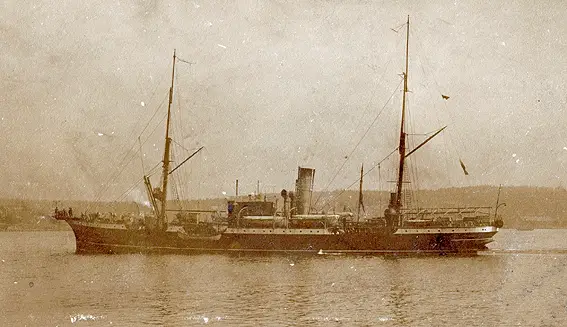
CS Mackay-Bennett with her stern full of coffins as she returns to Halifax with Titanic's dead. (Click image to enlarge)
The manner of Hugh McElroy's death is unknown. But unlike the other senior officers who died in the sinking, his body was recovered.
The Cable Ship (C.S.) Mackay-Bennett was the first of four ships chartered by the White Star Line to search for bodies, departing on the 17th of April - just two days after the sinking. Due to the number of bodies being recovered from the site of the disaster another ship was dispatched - the Minia - to assist. After seven days of searching the Mackay-Bennett had recovered a total of 306 bodies (numbered 1 - 306).
It is body numbered 157 that turned out to be McElroy, recovered on the 22nd of April, 1912. A note on this date: Most references list Hugh's body as being recovered on the 22nd of April, 1912 and buried on the same day at 8pm. However there are other references that place this on the afternoon of the 23rd of April, 1912, and then buried at sea the following day at midday during a pause in the recovery efforts due to especially poor weather on the 24th. At present the dates of 23rd/24th are unconfirmed so we are using the date of the 22nd, as used in Frank McElroy's biography and on Encyclopedia Titanica, until further information comes to light.
According to a diary kept by Clifford Crease, a 24 year old mechanic on board the MacKay-Bennett on the 22nd of April 1912: ‘Weather fine picked up twenty six bodies eighteen men, seven women and one boy. Burried at sea; six women and nine men at eight fifteen PM.’ In the diary of Frederick Hamilton, cable engineer Mackay-Bennettwe have further information as to the time of the recovery:
"We steamed close past the iceberg today, and endeavoured to photograph it, but rain is falling and we do not think the results will be satisfactory. We are now standing eastwards amongst great quantities of wreckage. Cutter lowered to examine a lifeboat, but it is too smashed to tell anything, even the name is not visible. All round is splintered woodwork, cabin fittings, mahogany fronts of drawers, carvings, all wrenched away from their fastenings, deck chairs, and then more bodies. Some of these are fifteen miles distant from those picked up yesterday. 8.p.m. Another burial service." (Diary of Frederick Hamilton, Courtesy Royal Museums Greenwich)
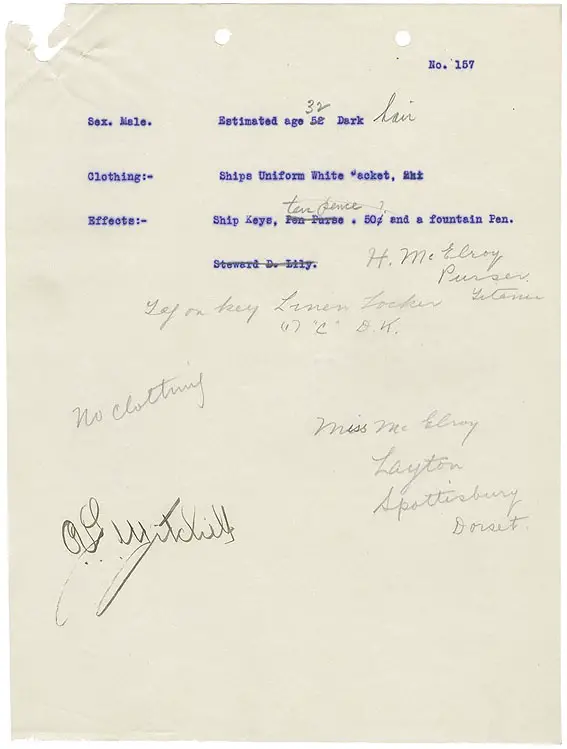
The "Fatality Report" for body no. 157 that was later identified as Hugh McElroy. It is interesting to note he was initially identified as "Steward D Lily". (Source: Records of the Medical Examiner for the City of Halifax and Town of Dartmouth,
RG 41, Series C, Vols. 75, 76 & 76A, held at the Nova Scotia Archives.)
The initial details of the body recovered are listed in the 'Disposition of Bodies ex Titanic' list is as follows:
Unidentified, Male 157 Buried at sea.
Wore ship's uniform.
Key, tagged linen locker No. I C Deck.
Address found in effects: Miss McElroy, Layton, Spottisbury, Dorset.
(Source: Nova Scotia archives)
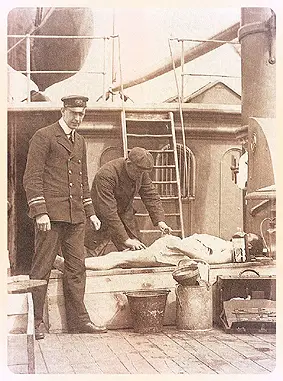
An unidentified body recovered by the
Mackay-Bennett. (Click to enlarge)
It is interesting that he was listed as "unidentified" despite the name "McElroy" on the address. In fact, "from a fragment, they came up with the name of D. Lily, but in fact, there was no one of this name on board." ("Irish Titanic Officer Hugh Walter McElroy", by Senan Molony, Irish Central) The body was that of Hugh McElroy. Later these details were clarified as:
NO. 157.
— MALE.
— ESTIMATED AGE, 32.
— HAIR, DARK.
CLOTHING - Ship's uniform; white jacket; ship's keys; 10 pence; 50 cents; fountain pen.
CHIEF PURSER.
— NAME — HERBERT W. McELROY.
It is of note that his name Hugh is incorrectly listed as "Herbert" something that has annoyed biographer Frank McElroy:
"The body was not immediately identified as Hugh McElroy, (but was recorded as Herbert?) this was a mistake made at the coroners court in Halifax, when his effects were checked and identified by Mr Percy Mitchell who signed a declaration and certified the name of the deceased person as Herbert McElroy, Purser, Titanic; but as he was dressed in ships uniform and wearing a white officer’s dinner jacket, when he was found, they investigated further and they found out who he was, but because of the mistake made in the coroners court by Mr Percy Mitchell, giving him the name of “Herbert” this would in a way, haunt Hugh right up to the present day, a thing I have given up trying to rectify, on the many web sites on the internet." (Frank McElroy, Encyclopedia Titanica)
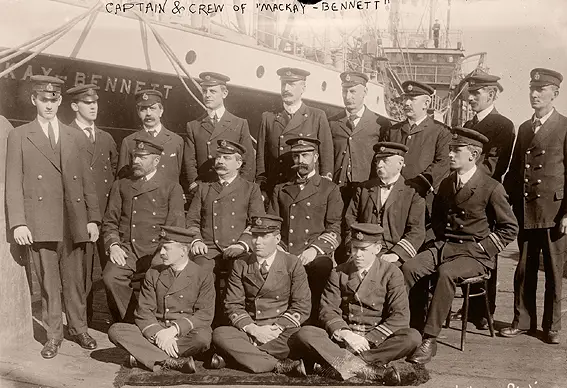
The Captain and crew of the CS Mackay-Bennett who recovered McElroy's body.
(Click image to enlarge)
The "ship's keys" were tagged “Linen locker No 1 - C Deck” Also an address was found: “Miss McElroy, Layton, Spottisbury, Dorset” (Mary McElroy who was Hugh’s sister). Senan Molony noted: "A scrap of paper in the name of his wife was also taken from the remains and later provided corroboration of his identity." ("Irish Titanic Officer Hugh Walter McElroy lost his life but was 'larger than life'," Irish Central)
Hugh McElroy's body was buried at sea at 8 pm on 22 April 1912. The service was most likely taken by Canon Kenneth C. Hind who was from All Saints Cathedral in Halifax. Reverend Hind later gave his opinion of a burial at sea:
"Anyone attending a burial at sea will most surely lose the common impression of the awfulness of a grave in the mighty deep. The wild Atlantic may rage and toss, the shipwreck mariners cry for mercy, but far below in the calm untroubled depth, they rest in peace." ("Voices from the Carpathia: Rescuing RMS Titanic" by George Behe)

Hugh McElroy's fountain pen that was found on his
body. The pen was a gift from his father.
Image credit: Frank McElroy. (Click to enlarge)
Frederick A Hamilton, cable engineer aboard the Mackay-Bennett described the process of burial in his diary - this entry is for the 21st, the day before McElroy's body was buried:
8.p.m. The tolling of the bell summoned all hands to the forecastle where thirty bodies are ready to be committed to the deep, each carefully weighed and carefully sewn up in canvas. It is a weird scene, this gathering. The crescent moon is shedding a faint light on us, as the ship lays wallowing in the great rollers. The funeral service is conducted by the Reverent Canon Hind, for nearly an hour the words For as must as it hath pleased - ‘we therefore commit his body to the deep’ are repeated and at each interval comes, splash! as the weighted body plunges into the sea, there to sink to a depth of about two miles. Splash, splash, splash.’ (Diary of Frederick Hamilton, Courtesy Royal Museums Greenwich)
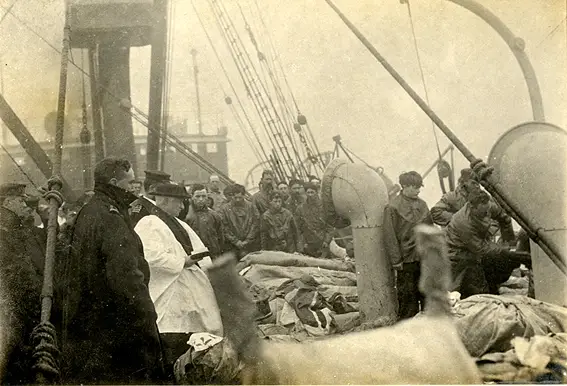
A service being conducted by the Reverend Hind on the Mackay-Bennett. It is believed to be the afternoon of April 24, 1912, and possibly shows a burial at sea.
(Click image to enlarge)
This leads to the question as to why such a senior ranking member of the crew was not returned to his family for a burial. Some have erroneously suggested that bodies that could not be identified, or were in a poor state or of a lower class or rank, were buried at sea. Frank McElroy believes it was the condition of Hugh's body as to why he was buried at sea: "But because of his condition decomposed beyond preservation it was decided by Captain F. H. Larder of the “MacKay-Bennett” that he should be buried at sea, so at 8 p.m. on the 22nd April 1912. Hugh was committed to the sea as one of 15 who were buried that day."("The Life and Times of Hugh Walter McElroy, Chief Purser of R.M.S. Titanic,"" by Frank McElroy).
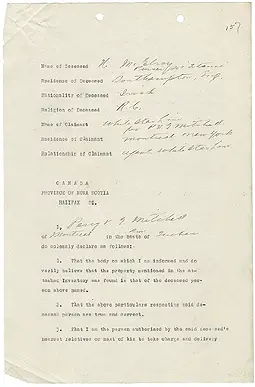
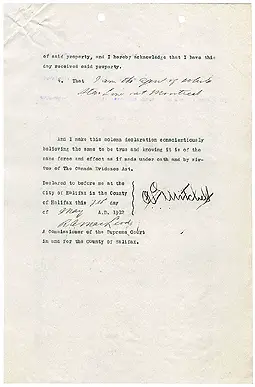
Above: A letter detailing the recovery of items from Hugh McElroy's body that were collected by Percy Mitchell, the White Star Line’s manager in Montreal, who signed the declaration to obtain the effects from the coroner’s office in Halifax, Nova Scotia.
(Click image to enlarge)
However, it seems the Mackay-Bennett was simply ill-prepared for the number of bodies that were found. "Once additional supplies were obtained from the Sardinian on the evening of 23 April 1912 all burials at sea stopped and all bodies were kept regardless of class, identification or state. No sea burials occurred after 24 April 1912." (Encyclopedia Titanica)
It is also noticeable that the 6 bodies found before McElroy (numbers 151 - 156) and three after him (158 - 160) were also all buried at sea, perhaps indicating they had run out of supplies. Of the 306 bodies recovered 116 were buried at sea.
White jacket?

McElroy pictured aboard the Olympic
in his white summer uniform - perhaps
different from his white dinner jacket.
It is interesting that McElroy was found wearing a "white jacket" which perhaps is part of the reason why he was firstly misidentified. However, Frank McElroy believes the white jacket was what he was wearing while dining in the First class restaurant:
That night he had been [as was his normal duty] in the 1st class restaurant, dining with his passenger friends, of which he had many [see my web site], he would have been wearing a small white diner jacket not a white steward's jacket…. That particular night, there was not much time for changing one’s uniform or anything else. (Encyclopedia Titanica)
While his body was buried at sea, the effects found on him were not. The White Star Line arranged to have these effects returned to his family:
Percy Mitchell, the White Star Line’s manager in Montreal, later signed a declaration to obtain the above effects from the coroner’s office of Halifax, Nova Scotia. He certified the name of the deceased as H. McElroy, Purser, SS Titanic, his residence as Southampton, England, his religion as Roman Catholic, and his nationality as Irish. The official name of the claimant, issued in the space provided, was ‘White Star Line’. It was perhaps appropriate. His white-clad corpse was the most senior member of the crew to be recovered, and he had been one of their brightest lights for a long time, ever the embodiment of the White Star Line. ("Irish Titanic Officer Hugh Walter McElroy lost his life but was 'larger than life'", Irish Central)
The "Address" & Retirement?
Regarding "the address" discovered on Hugh's body ("Address found in effects: Miss McElroy, Layton, Spottisbury, Dorset") Frank McElroy has an interesting although undocumented explanation:
"The note (described as "the address") that they found on Hugh, must have been the last thing he wrote to his beloved wife barbara, which must have been scribbled quickly, given the time facture. Hugh wanted to make amen's[sic], for any upset he may of caused Barbara, re: regarding a suggested move to his beloved Cornwall, where as Barbara wanted to move back to her father's house in Ireland due to the fact of his health was failing, after all, this was supposed to be Hugh's last trip, then he wanted to retire from the sea, as he had set his sights on becoming the Passenger Manager for the White Star Line." ("Death of Purser", by Frank McElroy)
There are no further details or references regarding McElroy wanting to retire - so it is quite likely speculation on the part of the author.
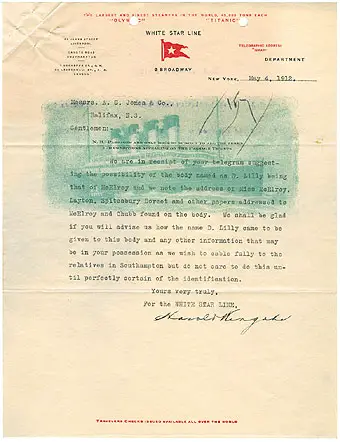
A letter from the White Star Line to their Halifax agents,
A.G. Jones and Company who had chartered the
MacKay-Bennett, questioning why McElroy's body
was firstly identified as "D.Lilly". Credit: Nova Scotia
Archives (Click image to enlarge)
Interestingly, on the 4th of May 1912 a letter from the White Star Line was sent to their Halifax agents, A.G. Jones and Company who had chartered the MacKay-Bennett, responding to a "telegram suggesting the possibility of the body named D.Lilly being that of McElroy" and questioning why McElroy's body was firstly identified as "D.Lilly and wanting to make certain of the identification.
Coincidences
According to Frank McElroy there are three interesting coincidence that took place during the recovery phrase of the Titanic disaster connected to Chief Purser Hugh McElroy. They are:
(1) At 6.45 on the 19th April 1912, before reaching the wreck site, the MacKay-Bennett picked up a lifebelt with the Allan Line markings on it. (Mr. John Ennis, Hugh’s father-in-law was formerly Passenger Manager of the Allan Line).
(2) The MacKay-Bennett received new supplies from Sardinian again of the Allan Line.
(3) One of Purser McElroy’s friends at Bodmin Priory, brother Philip Corr, went on to be a Priest and was travelling on the Carpathia when it rescued the survivors from the Titanic
News reports
Once confirmation came through that McElroy was included in those who perished in the disaster, there were several newspaper reports and details of services including:
Bodmin Priests Bereaved
At Mass at St Piran’s Roman Catholic Church in Truro, on Sunday morning, prayers were offered for those who went down with the “Titanic”, and a special mention was made of Mr Hugh McElroy, the chief purser, brother of the present Prior of Bodmin and Mr Reginald Smith one of the “Titanic’s" engineer, brother of Father Smith, both of whom were drowned.
( Coventry Standard, 26th – 27th April 1912)
Irish Priests Lost
Amongst various stories of church services after the disaster, Roman Catholic priest of St Mary’s Church in Coventry; on Sunday morning Reverend R. F. Rea said in church that amongst those lost were two Irish priests and a number of Catholics belonging to the crew including Chief Purser Hugh McElroy (sic), whose two sisters were educated at St Joseph’s Convent, Gosford Green in Coventry, where their mother remains in residence at that time.
(Atlantic Daily Bulletin 4/1999)
Probate and Titanic Relief Fund
On the 31st of July 1912, his widow Barbara administered what remained of Hugh's estate valued at £4330, 13s, 3d, which is the equivalent of £505,778 in 2020, based on inflation. The probate read:
McElroy, Hugh Walter of Polygon House, Southampton. Ship’s purser. Administration: London 31st July 1912 to Mrs Barbara McElroy widow, effects £ 4330.13. 3d.
The Titanic Relief Fund was initiated by the Lord Mayor of London to raise money by public subscription to assist dependents of crew and passengers who were left destitute, and sooversaw financial aid to widows and orphans of the Titanic disaster for many years. In the March 1913 Mansion House “Titanic” Relief Fund Booklet, Hugh's family were allocated "Number 512" :
Number 512. McElroy, Jessie, (mother). Barbara (Nee Ennis), (widow) and Charlotte, (sister), all class “A” dependants.
Memorial Grave
There is a memorial grave to Hugh McElroy at Anfield Municipal Cemetery, Liverpool, England, in the Roman Catholic Section 5, plots 254 & 296.
The grave is inscribed with the writing "The burial place of Hugh McElroy" -at first a misleading statement considering his body was actually buried at sea, but it actually refers to Hugh's grandfather, also named Hugh who died aged 36 on the 3rd April 1870. However according to Frank McElroy there was a burial of his belongings in a coffin:
"Barbara in turn sent the note (described as "the address"), to the family, to be placed in his coffin before the burial, along with all his other belongings, which was forwarded by White Star, with the exception of his fountain pen, which still remains in our family." ("Death of a Purser" by Frank McElroy)
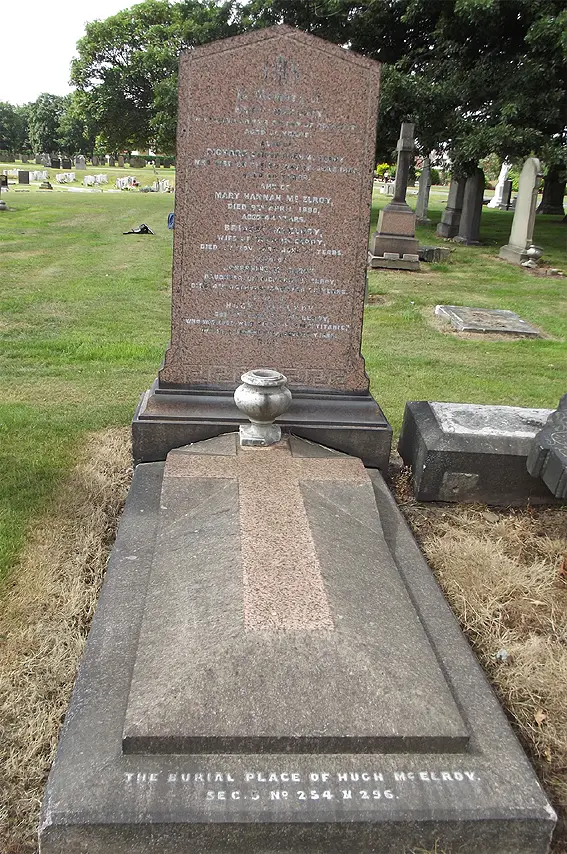
Memorial grave to Hugh McElroy, Anfield Municipal Cemetery, Liverpool. Image credit: findagrave.com/Robert Anderson (Click image to enlarge)
IN MEMORY OF
HUGH MCELROY
WHO DIED ON THE 3RD DAY OF APRIL 1870
AGED 36 YEARS.
ALSO OF RICHARD, SON OF HUGH MCELROY,
WHO DIED ON THE 9TH DAY OF JULY 1888,
AGED 44 YEARS
AND OF
MARY HANNAH MCELROY,
DIED 9TH APRIL 1890,
AGED 44 YEARS
BRIDGET MCELROY,
WIFE OF HUGH MCELROY,
DIED ?? NOVEMBER ?? AGED ?? YEARS
ALSO OF
JOSEPHINE MCELROY
DAUGHTER OF RICHARD MCELROY,
DIED 4TH OCTOBER ???? AGED ?? YEARS
ALSO OF
HUGH MCELROY
SON OF RICHARD MCELROY
WHO WAS LOST WITH HIS SHIP RMS "TITANIC"
ON THE 15TH APRIL 1912, AGED 37 YEARS.
R.I.P.
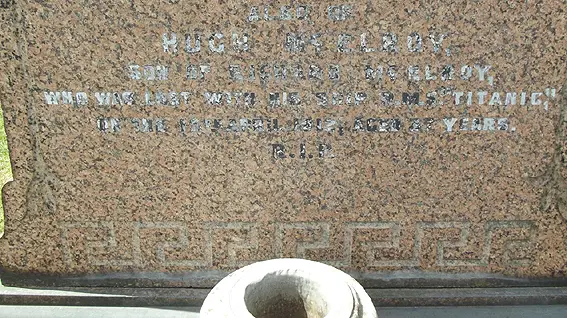
A close up on section refering to Chief Purser Hugh McElroy, at the McElroy grave, Anfield Municipal Cemetery, Liverpool. Image credit: findagrave.com/Robert Anderson. (Click image to enlarge)
Remarriage and Death
Two years after the loss of her husband, Barbara remarried. According to biographer Frank McElroy this was allgedly to a "George C Booker":
"Death of a Purser" by Frank McElroy: "Barbara reutrned to Toxteth, Liverpool and on February 1914 quite suddenly got married to a Mr George C Booker, they both moved back to Ireland and in a period covering just over two years she gave birth to a girl and two boys (twins), one of the boys moved to Nottingham, while Barbara's remaining family stayed in Ireland."
However, this does not align with the facts - the Ennis family Bible has an entry -"Barbara Ennis (McElroy/Clancy)" and in another excerpt clearlt lists her two marriages to Hugh McElroy ("lost in Titanic disaster April 1912) and "John Clancy" who she "married June 3rd 1914". Encyclopedia Titanica is thus most likely correct in their description:
Encyclopedia Titanica: "Barbara McElroy was remarried on 3 June 1914 in Kingstown (modern-day Dún Laoghaire), Co Dublin, becoming Mrs John Clancy. She remained in Ireland for the rest of her life and died at Springmount, Ballymitty, Co Wexford on 18 December 1953.""

Except from the Ennis family Bible, showing Barabra's two marriages to Hugh McElroy and John Clancy (courtesy of Joan O'Brien)

Hugh's wife Barbara on horseback, in an undated photograph. As she has the name McElroy it must be prior to her marriage to John Clancy and thus be between 1910 and 1913. (Courtesy of Joan O'Brien)
The remarriage had an effect on the Titanic Relief Fund - Barbara's was stopped, however Hugh's mother Jessie was to be still cared for:
Case Number 512 . McElroy. The dependants in this case were the widow and the mother. The widow has since remarried and therefore off the Fund. The occupation of the deceased was Purser, and he allowed his mother £240 per annum, his wife had a separate estate. The widow recognized that the scheme did not meet the equity of the case as between herself and mother, and she therefore voluntarily paid out of her widow’s allowance 7/6d per week in augmentation of 7/6d per week paid from the Fund. Since the remarriage of the widow however, this special arrangement has ceased, leaving the mother who is a widow, solely dependent upon the Fund allowance. In view of these facts the Committee considers the case of Mrs. McElroy, (mother) as one of comparative hardship and recommend payment of supplementary grant at the rate of 7/6d per week. The dependent is now 66 years of age.
Dated 3rd December 1914. Authorized from January 1915.
(The “Titanic” Relief Fund, Minute Book number 2, Southampton Area, Southampton Committee of the “Titanic” Relief Fund, November 1914)
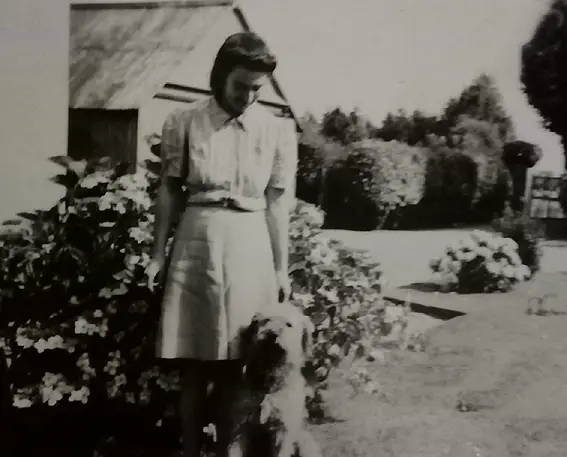
Barbara photographed in her later years in an album marked 1942, but perhaps earlier. (Courtesy of Joan O'Brien)
Barbara's father John J. Ennis J.P, died at Springwood on the 1st of July 1921 aged 86 years. (Note that Frank McElroy's book Death of a Purser incorrectly lists his date of death as 13 October 1913). Barbara herself passed away on the 18 December 1953 and was buried in the same family plot as her father. Her name is listed under her remarried name of "Barbara Clancy."
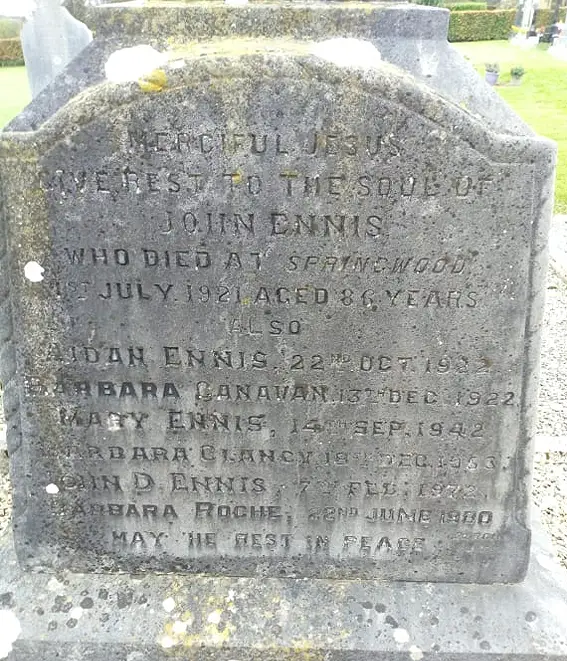
The Ennis family plot with John Ennis and Barbara Clancy (formerly McElroy). (Courtesy of Joan O'Brien)